 |
|

|
 |
TABLE of CONTENTS
 |
District 2 employees help save pilot after plane crash |
By TJ Melcher, District 2 public affairs coordinator
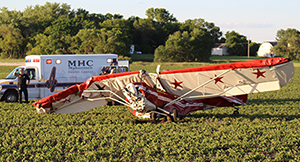
A plane crashed near the Mahnomen airport June 21. District 2 employees, Doug Zarling and Erik Fitzgerald, rescued the pilot from the plane. Photo by Sue Gruman Kraft, Mahnomen Pioneer |
Two District 2 employees were driving north on Hwy 59 near the Mahnomen airport June 21 when they saw a plane flying very low bank to the right and then crash into the ground.
The employees, Doug Zarling and Erik Fitzgerald, had wrapped up work for the day on the Hwy 59 resurfacing project and were driving back to Mahnomen to complete some paperwork when they saw the plane go down. They immediately called 911.
When they approached the crash site, they heard the pilot call out for help. Fuel was leaking from the plane, so they helped get him out of the plane and waited until emergency services arrived a short time later.
“It didn’t seem real at first,” said Fitzgerald. “All of a sudden the plane took a sharp turn and went straight down. As we walked up to the plane we heard the pilot yell, ‘Somebody help me, I’m hurt, I’m hurt.’ We got him unbuckled and pulled him away from the plane.”
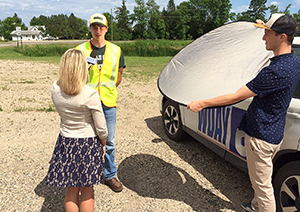
Erik Fitzgerald, District 2, interviews with WDAY TV after he and Doug Zarling rescued a pilot from a plane after crashed near Mahnomen. Photo by Jerimiah Moerke |
The pilot, Mark Habedank, was taken to Sanford Medical Center in Fargo.
Fitzgerald said he and Zarling don’t consider themselves heroes.
“Anybody driving down the road would have pulled off and helped,” said Fitzgerald. “I’m just glad we were there to help.”
It was teamwork of experience and youth. Zarling has been with MnDOT for 40 years, while Fitzgerald started as an intern and is in his second year with District 2.
|
 |
|

|
 |
TABLE of CONTENTS
 |
Employees will need alternate route when traveling I-35W northbound to Training and Conference Center |
By Kent Barnard, Metro District public affairs coordinator
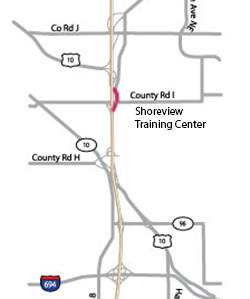
The ramp from northbound I-35W to Ramsey County Road I and the ramp from County Road I to northbound I-35W are closed for construction. |
If employees are traveling north on Interstate 35W to the Shoreview Training and Conference Center at 1900 County Road I West in Shoreview, you’ll need to find an alternate route. The ramp from northbound I-35W to Ramsey County Road I is closed until early September. The loop from County Road I to northbound I-35W is closed permantly. The closures are needed for construction on County Road I just east of the interstate.
Suggested alternate routes include continuing north on I-35W to County Road J and then back south on I-35W or south on Rice Creek Parkway to reach County Road I.
The project includes construction of a roundabout at the ramp from I-35W northbound, Rice Creek Parkway and Old Highway 8 (which leads in to the Arden Hills Driver Services facility). The work also includes improved trail access, raised medians, new road shoulders and a new roadway between County Road H and County Road I on the east side of I-35W. Once the roundabout is completed, County Road I motorists will travel south on the new Old Hwy 8 frontage road to County Road H to reach northbound I-35W.
For more information visit the project website. |
 |
|

|
 |
TABLE of CONTENTS
 |
Hwy 52 construction spans six projects in two districts on one website |
|
By Mike Dougherty, District 6 public affairs coordinator
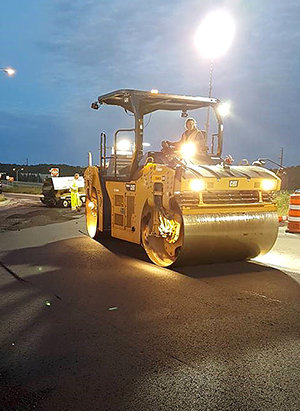
Crews pave a roundabout at Hwy 52 and Goodhue County Road 24 at Cannon Falls. Photo by Scuffy Paulson |
Hwy 52 is busy transportation corridor between the Twin Cities and Rochester, Minnesota’s third largest city.
As MnDOT talked in 2016 about projects coming up in 2017, a confluence of six projects were planned. On their own they might not be too disruptive, but when grouped along this 75-mile corridor, they had the potential to cast the roadway as a construction trail of horrors for the thousands of commuters, travelers and truckers that ply that highway daily.
District 6 joined forces with the Metro District, which has two projects north of Cannon Falls, the approximate border between District 6 and Metro District. A landing page on the MnDOT construction website was designed to group all of the projects together. It’s an approach tailored more toward motorists than distinguishing projects between MnDOT districts.
The web page had 1,100 visitors since the start of June, which is a good number for a general project in Greater Minnesota.
A roundabout modification project at Cannon Falls is completed. Meanwhile, resurfacing continues from Rochester to Cannon Falls, as does a bridge replacement and interchange improvement project on Hwy 58 over Hwy 52 in Zumbrota. The beams for the southbound Hwy 52 bridge over the Little Cannon River at Cannon Falls were just placed.
The replacement of the Hwy 52 bridge over Dakota County Road 42 and the expansion of that road continues on track. A project is set for July from Cannon Falls to Coates to modify access, add reduced conflict intersections and close a median crossing.
It was the two districts’ first effort doing some level of information coordination on a highway where multiple projects existed. It’s a highway that sees a range of average daily traffic from Rochester to the Twin Cities that runs from approximately 20,000 to 30,000 vehicles.
“It’s good to have a single starting point for motorists interested in what lies on their path,” said Anne Meyer, District 6 public affairs coordinator. “We’ll likely refine and improve, but thus far, we think it was a good start and has helped fuel motorists with good information to make smart driving decisions.”
More information on the Hwy 52 projects can be found on the corridor project website. |
 |
|

|
 |
TABLE of CONTENTS
 |
Rest area posters to raise awareness of human trafficking |
By Judy Jacobs

Human trafficking awareness posters like this one will be placed in 41 Class I rest areas across the state. Poster created by Transportation Leaders against Human Trafficking |
MnDOT began installing posters in 41 rest areas across the state June 14 to educate the traveling public about human trafficking and to encourage them to report suspicious activity. Nearly 20 million travelers visit Minnesota rest areas each year.
“According to the Federal Bureau of Investigation, the Twin Cities is one of the 13 U.S. cities with a particularly high rate of child prostitution, and Minnesota has the third highest number of human trafficking cases in the nation,” said Commissioner Charlie Zelle.
Human trafficking often involves travel, including the transport of victims from a base of operations to locations of exploitation.
“MnDOT’s responsibility for maintaining the quality and safety of multiple modes of transportation, including highways, airports, rail lines, transit systems and commercial vehicles, provides unique opportunities to see and stop human trafficking activities,” he said.
The posters include guidelines on how to recognize signs of human trafficking and potential victims and a toll-free hotline to report any suspicious activity.
In January 2017, Zelle signed a pledge to join Transportation Leaders Against Human Trafficking and make fighting human trafficking a MnDOT priority by developing and sharing resources to inform and empower MnDOT employees and the traveling public.
To learn more about MnDOT’s human trafficking awareness initiative, visit MnDOT’s website at: mndot.state.mn.us/humantraffickingawareness/. |
 |
|

|
 |
TABLE of CONTENTS
 |
MnDOT begins installing electric vehicle charging station signs on Interstate 94 |
|
By Judy Jacobs
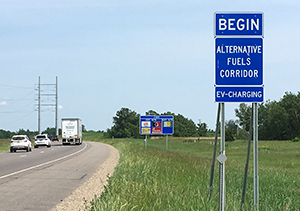
Electric vehicle station charging signs are being installed on I-94 north of St. Cloud. Photo by Mike Kiley |
Motorists traveling north of St. Cloud on Interstate 94 will see new “Electric Vehicle Charging Stations” highway signs along their route to indicate there is a network of public, fast-charging stations for electric vehicles nearby. This is the first of many electric vehicle charging stations signs that motorists will encounter along I-94 as the Fixing America’s Surface Transportation Act is implemented.
“MnDOT is excited to be a partner to promote and educate the public about zero emissions and the electric vehicle charging infrastructure,” said Commissioner Charlie Zelle. “We believe that alternate fuels and electric vehicles will be an important part of the future of transportation and can support progress towards the state’s greenhouse gas reduction targets.”
In 2016, the Federal Highway Administration selected I-94 from Port Huron, Mich., to the Minnesota/North Dakota border as one of 55 designated routes to promote alternative fuels and help drivers find vehicle charging stations nationwide.
This network spans 35 states and covers 85,000 miles. The alternative fuel corridors will be used to promote electric, hydrogen, propane and natural gas vehicles by encouraging development of fueling and charging stations along these routes.
MnDOT, in a partnership with the Minnesota Pollution Control Agency, submitted an application to designate I-94 as a ‘Zero Emissions Corridor,’ a type of alternative fuel corridor, to promote the electric vehicle charging infrastructure. Since the designation was announced, MnDOT led coordination with state departments of transportation from Minnesota, Wisconsin, Illinois, Indiana, Michigan, and the city of Detroit on a Memorandum of Understanding to re-brand this section of I-94 as the “Great Lakes Zero Emission Corridor.”
“The leading source of U.S. greenhouse gas emissions is transportation-related,” Zelle said. “We can reduce transportation emissions by supporting lower emission vehicles and alternative fuel corridors. By identifying where fueling stations can be found, we can increase the use of electric vehicles and improve air quality and meet the needs of current and future motorists.”
For a complete list of alternative fuel corridors, visit the FHWA website. |
 |
|

|
 |
TABLE of CONTENTS
 |
National Pollinator Week kicks-off new Monarch Highway logo |
By Judy Jacobs

The new Monarch Highway logo design was announced during National Pollinator Week. Logo developed through the National Wildlife Federation |
As part of the ongoing effort to raise awareness of pollinator habitat and preservation, Minnesota and five other states launched a new logo for the Monarch Highway/Interstate 35 corridor during National Pollinator Week, June 18-25.
“With the monarch population’s significant decline, it’s now more important than ever to preserve these critical habitats,” said Commissioner Charlie Zelle. “In launching the Monarch Highway logo, we hope to symbolize our continued efforts to protect this important pollinator and prevent the need to list it under the Endangered Species Act.”
The new logo represents the interaction of the monarch and the interstate highway system. The blue backdrop signifies the miles butterflies travel to reproduce in northern climates, while the yellow demonstrates the insect’s migration along the Monarch Highway corridor. The white dotted-lines represent lane markers guiding the monarch home.
In 2016, Minnesota, Iowa, Kansas, Missouri, Oklahoma and Texas transportation departments and the Federal Highway Administration signed a memorandum of understanding to improve pollinator habitat by designating the 1,500-mile I-35 corridor as a route on which land along the interstate could be developed to increase plants and provide refuge and food for monarch butterflies and other critically important pollinating insects.
"State roadways provide acres of habitat ideal for pollinators, but that’s only a small portion needed for pollinator recovery," said Zelle. "It’s important to build awareness and education about pollinator needs along the I-35 corridor to ensure monarch butterflies and other pollinators can flourish.”
Monarch butterflies born in late summer or early fall migrate south to winter in Mexico. In the spring, the butterflies return to the southern United States and lay eggs. Successive generations of monarchs continue moving north, which takes them along the I-35 corridor and finally into the northern United States and Canada. These monarchs begin the cycle over again by completing the 1,500-mile trek back to Mexico.
Visit MnDOT’s pollinator website at mndot.gov/pollinators/. See also also Monarch Highway proposed for I-35 Corridor from Mexico to Minnesota (MnDOT Newsline, March 2, 2016). |
 |
|

|
 |
TABLE of CONTENTS
 |
Contracting is streamlined so only two quotes are needed |
By Mindy Heinkel, Office of Maintenance
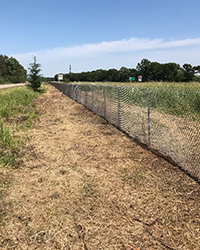
In this fence project on Interstate 35 in the Metro District, trees and brush were cleared by a certified small business. Photo courtesy of Extreem Forestry, LLC |
Although direct negotiated contracts have been in existence for many years, they flourished in fiscal year 2016 in MnDOT’s Metro District. An idea came about to streamline a contracting method under Minnesota Statute 161.32 subd. 2. to help with maintenance work. This idea is so straightforward that basically only two quotes are needed.
Additionally, the contract cannot exceed $150,000 and the work cannot begin until a purchase order is approved. These contracts are now formally called “negotiated maintenance contracts.”
“Two quotes and go, baby,” said Mike Leegard, Claims Engineer, Office of Maintenance.
MnDOT received approval to do a pilot project where several contracts were successfully executed using the “direct negotiated” method. During the pilot phase, MnDOT also realized this would be a great opportunity to try to assist small business owners and act as prime contractor on smaller contracts to expand their skillsets and gain experience working with MnDOT.
“Negotiated maintenance contracts provide a great opportunity for disadvantaged businesses to break into the marketplace, learn about the state contracting process and deliver on work we really need to get done,” said Steve Lund, director, Office of Maintenance.
NMCs were deemed such a success that in FY17 they became a statewide initiative.
MnDOT staff statewide have continued to work hard on shaping and executing these contracts so they are successful in helping our maintenance forces meet their needs, while providing opportunities for communities, in which these projects occur, to prosper. This innovative contracting method incorporates new practices to supplement traditional contracting, incorporates innovation and reduces costs while supporting our communities.
WIG 2.0 has offered the ideal platform to take this initiative to the next level. MnDOT is committed to earning customers’ trust both internally and externally. MnDOT has specific goals around NMCs within the WIG 2.0 Goal Area: General Maintenance and Procurement. This goal is to earn customer trust and hopes to assist in advancing equity in those contracts that do not have formal, certified business goals like Disadvantaged Business Enterprise goals, Targeted Group Business goals, Veteran goals, etc.
Teresa Geotzinger, president, Stonebrook Fence said, “Our company worked on two fence projects (Hwy 90 and Interstate 94). Both projects greatly benefited our company and our employees. The experience and knowledge we gained was priceless.”
With anything new there are some challenges and bumps in the road. Contracted businesses of all sizes, along with MnDOT’s maintenance staff across the state, have embraced this effort and stepped up to the challenge, collaborating and working together. Customers internally and externally that might not have met or worked together are now working together on common goals. Currently all eight MnDOT districts have one or more NMCs executed or underway. Some of the work types that have been addressed using NMCs are: tree removal, fencing, culverts, directional boring, slope repair, guardrail and mowing. Between the pilot phase and FY17 there have been approximately 35 projects let with over 16 small businesses being awarded contracts, and in some instances, multiple times.
District 7’s Heidi Sexton, transportation program specialist 1, and Gerald Krebs, transportation operations supervisor 4, noted that District 7 will have completed four projects under the NMC process before the end of FY17. They agree that these projects would not have been completed without the NMC process.
In the Metro District, Bill Augello, transportation operation supervisor 2, Maple Grove truck station said, “NMCs have helped us get some problem areas addressed that we normally would not have time or staffing for.”
“I am pleased to see so much interest among the districts in providing these opportunities for small businesses to work as prime contractors for MnDOT,” said Nancy Daubenberger, assistant commissioner, Engineering Services Division. “I’m also very grateful to the WIG teams for all the work they are doing to remove barriers and have NMCs become part of our contracting culture. In the first year of WIG 2.0 we moved the needle on the lead measure of number of contracts about halfway to our ultimate target.”
The Office of Maintenance is the point of contact for NMCs. If you want more information or have questions, contact Mindy Heinkel at mindy.heinkel@state.mn.us.
Special thanks to Statewide Maintenance forces, the Office of Construction and Innovative Contracting, the Office of Civil Rights, District Construction Offices, the Chief Counsel’s Office, the Resource Investment Council, the WIG Team, Senior Leadership, Procurement and Professional Technical staff for all their support in these efforts. |
|
 |
|

|
 |
TABLE of CONTENTS
 |
Geometric Design Support Unit ensures preliminary plans meet all standards |
By Rich Kemp
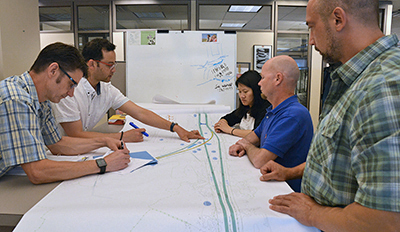
The Geometric Design Support Unit (from left) Doug Carter, Jamal Love, Gwen Mei, Josh Fleck and Almin Ramic look over a geometric design to ensure it meets state standards. Photo by Rich Kemp |
There are many steps in the planning process for state highway projects. Geometric design layouts play a big part in vetting concepts and developing construction plans.
The various design teams in the districts put together preliminary geometric layouts for specific projects that include what’s there now (existing conditions) and what they want to replace it with (proposed conditions). They describe the purpose and need of the project and the issues that need to be addressed. Once they have the geometric layout developed to a point where it can be reviewed for conformance to all applicable standards, they send them to GDSU at Central Office.
“We assign someone from our team to lead the review of the layout and coordinate with the other functional groups (ADA, Bike and Ped, Flexible Design, Traffic Safety, Signage, Maintenance, etc.) after we receive it from the district,” said Doug Carter, state geometric engineer. “We make sure the layout conforms to all applicable agency and AASHTO standards. We’ve developed a checklist to step through when reviewing a layout. We’ve made the checklist, along with all of our reference information, available on our website to make the process as efficient and transparent as possible.”
After an individual member of GDSU reviews the layout, the group comes together as a team. The reviewer walks the others through their observations, comments and the issues they see. The group acts as a sounding board for the reviewer, offers possible explanations for what they are seeing, and identifies any issues they didn’t catch. The lead reviewer then prepares a comment letter after receiving input from the other functional groups. The comment letter is sent to district staff for their review. They will review the recommendations, make changes or explain how they arrived at the solution.
When the GDSU team and district staff agree on the final layout, Carter signs off on the design review as the state geometric engineer. The team then presents the layout to Tom Styrbicki, Project Management and Technical Support director and state design engineer, for final approval. The project can’t move into final design without Styrbicki's signature.
“We want to be a design resource for the districts,” said Carter. “As a team we’ve reviewed every Level 1 layout and may see an issue that has come up before. We realize how much time has been committed to the design by the district staff, so we attempt to keep an open line of communication and comment respectfully and thoughtfully.”
The GDSU team also offers classes to district personnel and the consultant community on geometric design and layout. The next class is TORUS 5.0 roundabout design software. This year they taught Roundabout design software and MnDOT design guidelines and MnDOT preliminary layout geometric design classes.
For information on geometric design and resources, check out the GDSU website. |
 |
|

|
 |
TABLE of CONTENTS
 |
Chief Counsel staff readies employees for Business Data Catalog expansion |
By Angela Boardman, Office of Chief Counsel

Angela Boardman (standing) and Charles Stech (seated, maroon shirt), Office of Chief Counsel, provide training June 20 to Metro District employees (from left, counterclockwise) Sue Boyd, Anne Kubat, Carrie Barth, Lemell Johnson and Michael Beer. Photo by Jennifer W. Witt |
Perhaps you already are familiar with MnDOT’s Business Data Catalog, the interactive application that publishes descriptive information about MnDOT's data assets?
If so, you’ll be happy to learn that the BDC will be undergoing a major upgrade in the upcoming months to expand its functionality and help ensure the consistency and integrity of MnDOT’s data.
If the BDC is new to you, you’ll find it helpful in searching for data and applications, understanding data definitions and business terminology, locating and sharing data, and getting contact information for data stewards.
“With the Business Data Catalog, we’re documenting the collective knowledge of the agency,” said Jennifer W. Witt, records and information manager, Office of Chief Counsel. “This makes it reorganization-proof because the data is cataloged by concepts rather than offices or staff, which tend to change.”
In preparation for the upcoming changes to the BDC, Chief Counsel staff are visiting MnDOT’s districts this summer to provide training and guidance in the use of the BDC and the department’s records retention schedule.
Understanding metadata
There are many ways to define metadata. The short answer is that metadata is ‘data about data.’ This definition, while true, falls short because it does not explain that ‘data’ is a simplification of the broader world of information and information resources, which includes digital data elements, like those stored in database applications, but also includes business processes, concepts, objects and places.
Metadata is important because it is a discovery mechanism. At MnODT, data domain stewards and the subject area stewards are responsible for providing metadata for the catalog. Using this metadata for keyword searching in the BDC is one way to “discover” information resources.
If we consider a book as an information resource, how many things can we say about that book?
Who created it?
What is its title?
When was it published?
Who was the publisher?
What is it about?
How many pages does it have?
Who owns the rights to it?
What language is it in?
Metadata are the particular attributes, or features, of an information resource. At MnDOT we rely on both descriptive and technical metadata to document our information assets and make them “discoverable.” Consider the metadata elements for the following MnDOT document:
| DOC_TITLE: |
2016_CondemnMemo_34718 |
| CREATOR_NAME: |
Lewis, James H |
| DOC_TYPE: |
Condemnation Memo |
| LOCATION: |
eDOCs |
| CREATE_DATE: |
2016-02-27 |
| LAST_MODIFIED: |
2016-03-11 |
| RETENTION_TIME: |
7 years |
| DATA_CLASSIF: |
Public |
| FILE_FORMAT: |
.pdf |
| FILE_SIZE: |
83.6 KB |
| COMMENTS: |
Parcel files are missing from condemnation folder. |
To locate a document in an electronic system you would probably enter search terms much like the metadata elements listed above.
One last thing to know about metadata is that it is structured. Each facet of an informational entity is a discrete unit, formatted and organized as tabular data so that it can be sliced and diced and served up in multiple ways. Metadata, therefore, are structured statements that describe our information assets.
Related articles:
Second annual electronic data clean-up is underway
Just two days remain before the second annual electronic data clean-up competition comes to an end. Employees have until Friday, June 30, to reduce electronic data storage on their hard drives by following MnDOT’s records retention schedule. Just like last year, the office or district that reduces its electronic storage by the most percentage points will receive the coveted MnDOT Golden Hard Drive, according to Jennifer W. Witt, records and information manager.
“We updated MnDOT’s retention schedule this year, so be sure to check your office’s retention schedule carefully to see if there are any changes that affect you,” Witt said. “It is important that we follow the rules we set out for ourselves so we comply with state statute.”
Steps:
- Review electronic documents to determine if they are records or not. Records are recorded information, regardless of format or characteristics, made or received by an organization that is evidence of its operations, and has value, requiring its retention for a specific period of time.
- Delete all outdated non-records.
- Review all records and delete or dispose of records that have reached its retention period.
- Make sure there are no non-business related personal files and data on MnDOT’s network drives. This includes shared and individual drives.
- Record your clean-up activities on your timesheets as: Project ID (T0008102); Activity Code/Source Type (0023)
- Fill out a Records Destruction Report of all records you delete. You don’t need to fill out a report for non-record material, which include copies, drafts and meeting agendas.
The MnDOT Golden Hard Drive winner will be announced July 5.
“Reducing unneeded storage and following the retention schedule not only offers a real savings potential, but ensures we are following the rules regarding proper records management,” Witt said. “Thanks for your contributions to making our efforts a success.”
If you have any questions or concerns, contact Witt, at 651-366-3541. See also MnDOT’s Records Management Policy.
|
|
 |
|

|
|

|
 |
TABLE of CONTENTS
 |
On the Job: Barbara Nelson coordinates Adopt a Highway program in District 1 |
By Sue Roe
Do you or a co-worker have an interesting job to share with readers? Send us your ideas, and we’ll contact you for more information.
Recent employee profiles:
|
 |
|
| |
|



